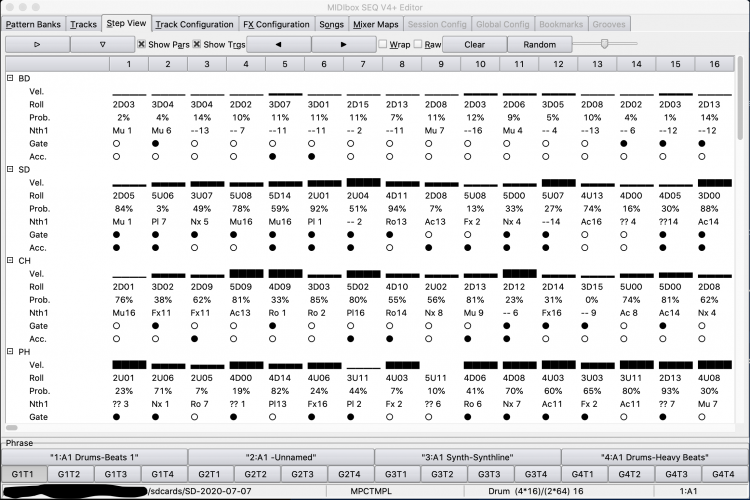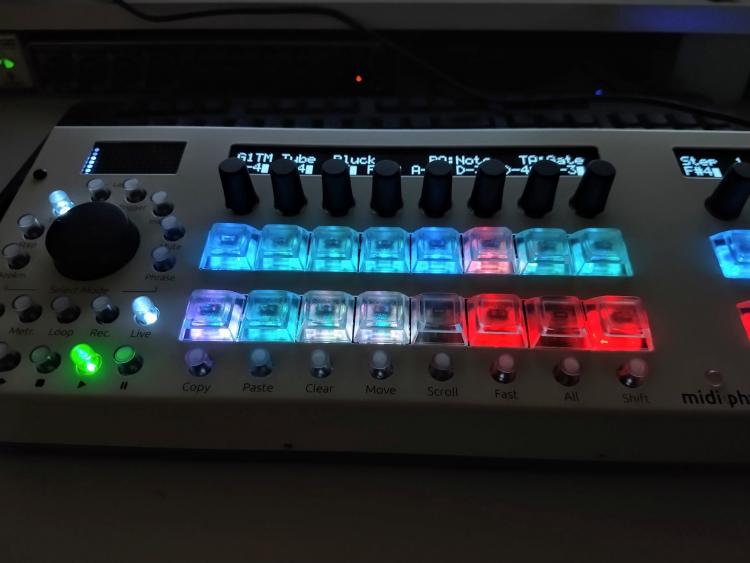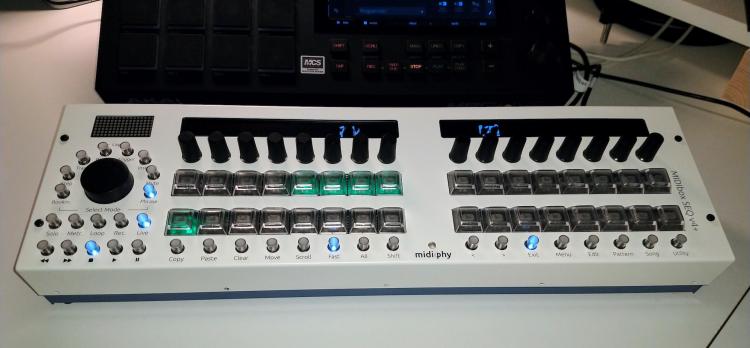
southpole
Members-
Posts
52 -
Joined
-
Last visited
-
Days Won
2
Content Type
Profiles
Forums
Blogs
Gallery
Everything posted by southpole
-
Hi Thorsten, It's definitely a good idea and (technically) feasible. A lot of the MIDI groundwork should be already covered by the rtmidi module and just looking what Python based MIDI sequencers like Braid are doing. So it's possibly a matter of "just" implementing the MIOS32 SysEx protocol, and the GUI integration, of course. My first priority is however to finalize file integrity checks during saves and streamlining (= debugging) the GUI before adding more features Cheers, Gerhard
-
Hi TK, nice you like it, i wasn't sure since it's not JUCE based ;-) doing some SysEx in Python is certainly interesting, i will put it on the to do-list. a faster (available) realtime solution is to buy a WiFi enabled SD card like Toshiba Flash Air. but i guess the reload of the files needs to be triggered by hand then. Cheers, Gerhard
-
Dear MIDIboxers, I would like to draw your attention to an editor for MB SEQV4+ SD Card contents i've been developing over the past few months. The program is still in alpha-state but I think it is time to announce it here in the hope of getting some early feedback. For now the code lives in my github repository here: https://github.com/gbrandt1/MBseqv4pEditor The code is scripted in Python 3 with a Tkinter GUI (but there is also a command line shell). To test, plug the SD card from the MB SEQ V4+ into your computer and open it in the editor. Looking forward to any comments you might have. Have Fun southpole
-
Hello Thorsten, The move to github is really excellent news! One more question on the license though: When the repository gets forked, even just to play around with personally, it is automatically public and so are any changes committed to the fork. Which in practice would amount to publishing a modified version of midibox. Does this still fall under your "personal use only" clause? Cheers, southpole
-
hi, i read the Cirklon user manual over my vacation recently and it seems to me accumulators are basically LFOs, where you program the core "by hand". the SEQ does have LFOs as opposed to the Cirklon.
-
maybe something to try is a plastic sheet in the shape of the bottom board installed -below- the top board with H- shaped cutouts where the switches are, which are bent upwards like wings to lightblock the sides of the switches between body and cap. this sheet could double as isolation sheet between top and bottom pcbs.
-
i see, this explains why the "nicest" wood i found so far is plywood from pin des Landes :-) the Okoumé they sell here is really sad quality with layers coming loose and i'm sorry they transported it so far even if it is called "nautical"... one local option i have is to go into the Jura and buy directly epicea from a saw mill - this was good for much of my furniture, but it's too soft and crude (noeuds) for synthesizer/sequencer cheeks.
-
yes! thanks Peter, awesome, this is exactly what i was looking for! you guys really thought of everything B-) at 256 steps this fx can provide 16x16 step parts in practicality and hence make up for one of the features i was missing with respect to the pyramid, called "patterns" there which is up to 16 different variations of tracks - on the seqv4+ i'll just use sections / step views. awesome! best regards, gerhard
-
Hi Thorsten, i was wondering if in step edit there is a possibility to play only the visible page in a loop? sort of like "section control" but directly from the selection row on the seqv4+ and always applicable to the 16 steps edited at the moment. second, i wanted to ask if it was already considered to have a transpose layer, transposing the note and chord layers on the same track, instead of requiring an extra track? kind regards, southpole
-
beautiful! i plan to make wood sides, too, but at a much steeper angle (45 degrees) and i don't have a CNC so i will probably use a thin plywood spacer. can i ask where do you buy nice wood in France? i checked in all the .*brico.* (regular expression) markets in my region and can't find anything nice and there is no good negocé around here.
-
see below B-) i picked 100 ohm on steps 1,5,9,13 and 220 ohm on the remaining steps for blue, giving a brighter blue on the downbeat and a slightly darker cyan on the other steps. looks better in reality than on the image. yes, i was hoping to charge AND connect via the USB port simultaneously. then unplug and take the sequencer to the club to play my set (i wish). sure, plugging the bank externally is the trivial solution but it's one more item+cable to think of.
-
i wasn't thinking of touching the caps but rather the switches themselves, around the shafts above the mezzanine below the caps. there seems to be some space even with depressed switch. on my Ambika i treated some LED lightpipes that were close to each other with shrink tube like that with good results. if we can find large enough shrinktube maybe rings can be cut and put on. this would however involve removing the caps again which i'm reluctant to do because i think the required force would be quite large and pull on the two little soldered legs ...
-
and one more thing ;-) we should talk battery ;-) to be fully portable it would be great to have a battery. for example, a mobile phone power bank could be attached with velcro tape under the right leMEC. there are some that switch automatically between charging and discharging. but i am not sure if / where it can be hooked up to the core? and we would need a switch which i know was decided against. but it should be easy to retrofit a round latching switch above the core breakout just to attach / detach the power bank. together with a WiFI SD card and Yamaha wireless MIDI plugs we would have a completely wireless SEQ V4+, that could be played like a keytar. for example.
-
another question regarding the Matias LEDs. i find the bleed is quite strong. so i did my homework and went back to read the entire design thread and i know this was considered and the current solution is the best possible. but i still wonder if anybody has tried to isolate, for example by painting the sides black? i don't see much space to insert light shielding, due to the caps.
-
Hi Andy, i would like to keep the red LED after all, meaning i would go for red/cyan/white scheme. in this case, if i understand correctly, i simply need to add another RJ going B-->3, correct? i tried this and it looks very cool but the blue component is too strong even with a 100 ohm resistor in RJ B->3. i don't really see the green admixture anymore. should i try a larger resistor (any experience here?) or do i need to add also something to SJ ? (in fact, i am not sure how SJ come into the game, could you perhaps share the part of the schematic showing a leMEC switch "column"?) cheers, southpole
-
well the material from the first cut is not just compressed, some of it is displaced and forms a circular burr. for sure i paid attention not to use much force at reinsertion and reuse the existing threads, but on some of the holes this circular burr from the first cut got fully detached on the reinsertion.
-
it's not the bluetooth version which probably has batteries, it's the "old" LPK25 that has ONLY a mini-USB connector, nothing else, no batteries. i played around a bit more now and got it sort of working after setting all the MIDI channels correctly :-) it is still very flaky as i get midi timeouts and step recording gives randomly 0,1 or 2 events on each key press. not really suitable for live use but i'm confident at least the soldering is ok :-) i will continue to try. speaking of batteries ;-) there seems to be some space in the case under the right leMEC :-)
-
hi, ok so i stuffed the jumper marked OTG on the core breakout. the LPK25 now briefly flashes once i supply power, but i get a MIDI TIMEOUT message on the display. but it was an opportunity to test the red LED on the core breakout ;-) do you have a list of devices that are known to work with your OTG implementation? btw. at the same time i have a few comments on the case: - maybe it would be good to convince Adrian to reduce the number of screws by half and cut real threads instead. i don't think all the screws are really needed and the self-tapping screws leave quite some metal shavings in the case as i found out after re-opening. those could perhaps lead to shorts at some point. - the bottom slots for standoffs under the MIDI8 module are 1cm too far inside and should be moved to fit the board in future cases. i think for longterm operation it is important to stabilize this long board also in the middle and not just at the ends. cheers!
-
hi, next question: i'm testing the USB OTG port now using an Akai LPK25. so far no luck, i don't even get power when i switch to OTG. any hints how to get this working? cheers, southpole (i changed my display name now to the moniker i use in the synth DIY world)
-
i went for the standard green/red scheme. but now seeing the finished product i think a cyan/blue/white color scheme would fit better with the case colors. since i want to reflow some of the Matias switches anyway to satisfy my OCD for perfect positioning (now in the case i see some of the gaps are not perfect ;-) ) i could maybe modify the color resistors from the back as well? is the color selection already discussed anywhere on the forum? Cheers, Gerhard
-
Hi Thorsten, thanks for your answer! it's exactly that binary format i'm trying to parse with a script outside the sequencer :-) i figured it out now: it's the array of 128 CCs in the track header. i overlooked it yesterday and got confused because it's not directly interpreted inside the bank file sources ... btw, i have a related idea to this CC block: the squarp pyramid supports so-called definition files to rename CCs for a given external synthesizer. it is just a text file with CC numbers and descriptive strings. this could be also interesting for the SEQ V4 CC layers to display CC functions in clear names. most of the machinery is already there for the internal CCs. it could maybe be added to the new label files your are developing, as a generalization from drums to all instruments. Cheers, Gerhard
-
hi, i have a question: i'm looking at the session files on the SD card and i'm trying to figure out where the track parameters are stored. as far as i understand from the code, they are internally kept as CC parameters (seq_cc) and treated like they are read from a track preset file (seq_file_t). but i don't have any preset files in my session so i don't understand where info is stored? can someone point me in the right direction? thank you very much, gerhard
-
and finally, after 6 years or so of dreaming, here's another one. really impressive work by everyone involved, thanks a lot for your hard work! it's crazy how much difference it makes to a device when there is no compromise made for mass producabitily. Andrian's cases have come a loong way since I got an Ambika case some years ago. and i love the Matias switches, it's just the best way to program sequencers, like the Cherry MX on my Nava. just wish all the MEC could be Mathias as well ;-) ... now to actually learn the software after dry-reading the manual for years ;-) (and waiting for Akai to implement multi-timbrality on the MPC so i can sequence it using the SEQ V4+)
-
hi, Reichelt runs also reichelt.fr, it can be used here in France no problem and cheaper than Digikey for small orders. for the 560 ohm resistor i replaced the 1206 with a standing small form factor THT.
-
yes i like 1206, just received a set from the land in the middle. unfortunately some of the boxes had opened in transfer so at some point i have to put the crumb puzzle back together (unless i got lucky and the required values are in the properly closed boxes)...




